Emily Dickenson诗歌赏析及解读
Emily Dickinson诗歌表现出来的女性意识

Emily Dickinson诗歌--女性意识觉醒的标志古往今来,妇女的地位一直受到男权的压迫。
生活在19世纪70、80年代的美国女性被认为是男性的附庸,作为社会的个体她们并没有自己独立的思想及灵魂,而是以家庭、丈夫为中心。
这不经令人想起中国古代社会要求妇女“三从四德”“三纲五常”的男权主义思想。
然而,随着社会的发展,人类的思想得到解放,女性意识在全球各个国家相继萌芽。
Emily Dickinson作为美国女性的代表,在诗歌中直言不讳,违背传统,表达了自己对男权社会的不满。
她的诗歌在内容以及用词方面都体现出女性意识觉醒的一面。
其中诗歌内容方面,这种不满的控诉主要体现在婚恋观、宗教观中。
而诗歌形式主要体现在选词和诗节的运用方面。
1诗歌内容1.1 婚恋观Emily寻求精神自由平等,试图摆脱社会约束。
在她生活的年代,若一名女子对他人有爱慕之心,她是不会直言不讳地表达出来的,因为社会传统要求她们学会控制自己的情感。
她们没有表达爱的勇气,只能被动地接受。
而Emily不顾世俗的看法,勇敢地倾诉自己心中的爱恋,主动去爱。
在why do I love you, sir?一诗中"Why do I love" You, Sir? Because— The Wind does not require the Grass To answer—Wherefore when He pass She cannot keep Her place…表达出男人、女人都是社会构成的主体,在恋爱关系中处于平等地位。
她虽为一名女子,可是同样有表达爱情的权利,因此她把行动付诸于实践。
Emily思想独立,敢于突破。
在她所处的时代,婚姻中的大多数女子都是以家庭为中心,以照顾丈夫和孩子为己任,没有自己的人生追求。
她在I’m a wife 中用反讽的手法将矛头直指那些安于现状,麻木满足的已婚妇女。
她们逆来顺受,面对社会角色的分配没有自己独立的想法。
Emily_Dickinson诗歌赏析
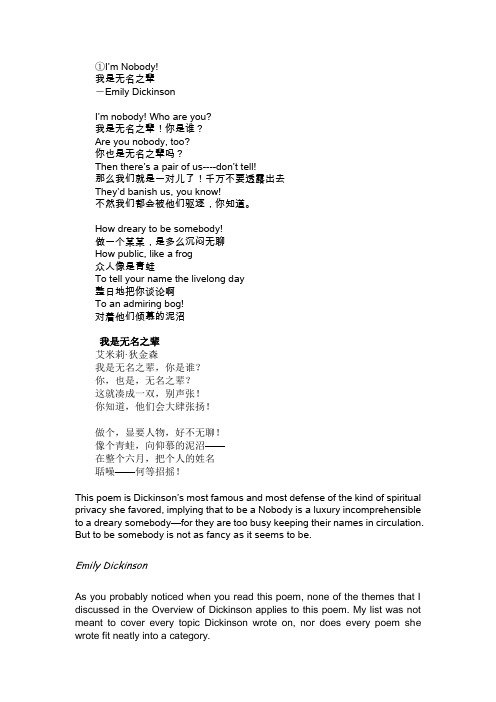
①I’m Nobody!我是无名之辈-Emily DickinsonI’m nobody! Who are you?我是无名之辈!你是谁?Are you nobody, too?你也是无名之辈吗?Then there’s a pair of us----don’t tell!那么我们就是一对儿了!千万不要透露出去They’d banish us, you know!不然我们都会被他们驱逐,你知道。
How dreary to be somebody!做一个某某,是多么沉闷无聊How public, like a frog众人像是青蛙To tell your name the livelong day整日地把你谈论啊To an admiring bog!对着他们倾慕的泥沼我是无名之辈艾米莉·狄金森我是无名之辈,你是谁?你,也是,无名之辈?这就凑成一双,别声张!你知道,他们会大肆张扬!做个,显要人物,好不无聊!像个青蛙,向仰慕的泥沼——在整个六月,把个人的姓名聒噪——何等招摇!This poem is Dickinson’s most famous and most defense of the kind of spiritual privacy she favored, implying that to be a Nobody is a luxury incomprehensible to a dreary somebody—for they are too busy keeping their names in circulation. But to be somebody is not as fancy as it seems to be.Emily DickinsonAs you probably noticed when you read this poem, none of the themes that I discussed in the Overview of Dickinson applies to this poem. My list was not meant to cover every topic Dickinson wrote on, nor does every poem she wrote fit neatly into a category.Dickinson adopts the persona of a child who is open, naive, and innocent. However, are the questions asked and the final statement made by this poem naive? If they are not, then the poem is ironic because of the discrepancy between the persona's understanding and view and those of Dickinson and the reader. Under the guise of the child's accepting society's values, is Dickinson really rejecting those values?Is Dickinson suggesting that the true somebody is really the "nobody"? The child-speaker welcomes the person who honestly identifies herself and who has a true identity. These qualities make that person "nobody" in society's eyes. To be "somebody" is to have status in society; society, the majority, excludes or rejects those who lack status or are "nobody"--that is, "they'd banish us" for being nobody.In stanza 2, the child-speaker rejects the role of "somebody" ("How dreary"). The frog comparison depicts "somebody" as self-important and constantly self-promoting. She also shows the false values of a society (the "admiring bog") which approves the frog-somebody. Does the word "bog" (it means wet, spongy ground) have positive or negative connotations? What qualities are associated with the sounds a frog makes (croaking)?Is there satire in this poem?Some readers, who are modest and self-effacing or who lack confidence, feel validated by this poem. Why?②To Make a Prairie…To make a prairieIt takes a clover and one bee,One clover and a bee,And revery.Revery alone will do,If bees are few.去造一个草原张祈试译去造一个草原需要一株三叶草和一只蜜蜂,一株三叶草和一只蜜蜂,还有梦。
the soul selects her own society赏析

《The Soul Selects Her Society》赏析《The Soul Selects Her Society》是英国诗人 Emily Dickinson 创作的一首著名诗歌,该诗通过描述灵魂选择自己的伴侣,表达了对自由、独立和个性的追求。
本文将对该诗进行赏析,探讨其主题、意象和语言风格。
《The Soul Selects Her Society》是 Emily Dickinson 创作的一首经典诗歌,该诗以灵魂选择自己的伴侣为主题,表达了对自由、独立和个性的追求。
在这首诗中,Dickinson 通过运用生动的意象和深刻的语言,使读者感受到灵魂选择的过程和意义。
首先,从主题来看,《The Soul Selects Her Society》探讨了灵魂在选择伴侣时所追求的自由和独立。
诗中,灵魂被描绘成一个自由、独立的个体,她有权选择自己的伴侣,而不是被他人安排。
这种对自由和独立的追求,反映了 Dickinson 本人对自由和个性的追求,也表达了当时美国社会中人们对自由和独立的渴望。
其次,从意象来看,《The Soul Selects Her Society》中运用了大量的比喻和隐喻,使得诗歌形象生动。
例如,“The soul selects her society——/Of course——”,这里的“soul”和“society”之间通过“selects”建立了一种主动的关系,暗示了灵魂在选择伴侣时的自主性。
再如,“The atom of a flower——/Is as a star——”,通过将花与星进行比喻,表现了灵魂在选择伴侣时所感受到的美好和幸福。
最后,从语言来看,《The Soul Selects Her Society》采用了Dickinson 典型的语言风格,即简短、深刻、富有哲思。
整首诗只有两句,但却充满了深刻的哲理,令人深思。
此外,Dickinson 还运用了破折号和省略号等语法符号,使得诗歌在语言上更加简练、精炼。
艾米莉·狄金森《我为美而死》及诗歌中死亡意象
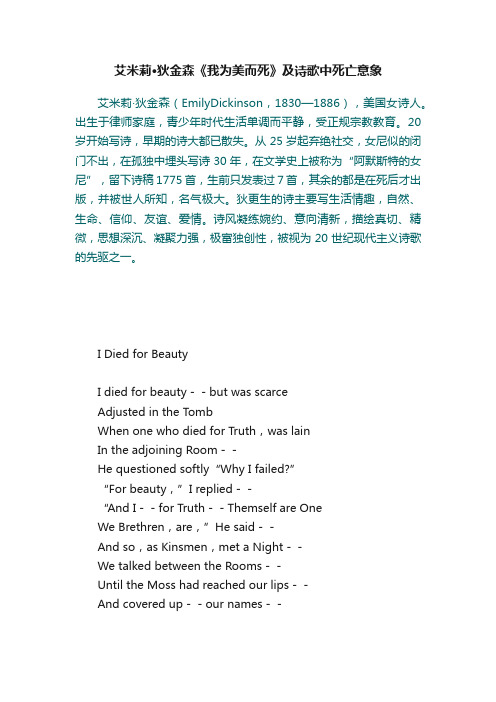
艾米莉·狄金森《我为美而死》及诗歌中死亡意象艾米莉·狄金森(EmilyDickinson,1830—1886),美国女诗人。
出生于律师家庭,青少年时代生活单调而平静,受正规宗教教育。
20岁开始写诗,早期的诗大都已散失。
从25岁起弃绝社交,女尼似的闭门不出,在孤独中埋头写诗30年,在文学史上被称为“阿默斯特的女尼”,留下诗稿1775首,生前只发表过7首,其余的都是在死后才出版,并被世人所知,名气极大。
狄更生的诗主要写生活情趣,自然、生命、信仰、友谊、爱情。
诗风凝练婉约、意向清新,描绘真切、精微,思想深沉、凝聚力强,极富独创性,被视为20世纪现代主义诗歌的先驱之一。
I Died for BeautyI died for beauty--but was scarceAdjusted in the TombWhen one who died for Truth,was lainIn the adjoining Room--He questioned softly“Why I failed?”“For beauty,”I replied--“And I--for Truth--Themself are OneWe Brethren,are,”He said--And so,as Kinsmen,met a Night--We talked between the Rooms--Until the Moss had reached our lips--And covered up--our names--我为美而死去我为美而死——对坟墓几乎,还不适应一个殉真理的烈士就成了我的近邻——他轻声问我“为什么倒下?”我回答他:“为了美”——他说:“我为真理,真与美——是一体,我们是兄弟”——就这样,像亲人,黑夜相逢——我们,隔着房间谈心——直到苍苔长上我们的嘴唇——覆盖掉,我们的姓名——《我为美而死》是女诗人对美与真理关系进行探讨的一首诗。
抽象 感性 跳跃——评爱米莉·迪金森诗歌中的意象

抽象 感性 跳跃———评爱米莉迪金森诗歌中的意象吴 娜爱米莉迪金森(Emily Dickinson1830~1886),美国文学史上一朵灿烂的奇葩。
在她那1700多首诗歌里,无论是《生命》之歌,还是《自然》之情;不管是《爱情》之颂,还是《时间与永恒》之叹;她都写得那样情真意切,别具风味。
她的诗只有时间,没有时代;只有空间,没有世界;只有上帝和死神,没有人群。
她似乎生活在远离世俗的纯净真空世界里。
南北战争,欧洲风云,文坛论战,一切都不曾进入她思想的花园。
她终日沉醉于形而上学的冥想和充满自潮意味的内省;占据她心灵的是死亡和那死后的虚无世界。
迪金森的诗是心灵的产物,她把自己的感情全部倾注到诗中,恰如她自己所言:“我的诗太靠近我的心灵”。
在形式上,迪金森的技巧寓丰富于简陋。
其句式往往打破常规文法,韵脚常常蹒跚不稳,音步时时零乱不堪。
她的思想放纵驰骋,她的表达自由潇洒,以致她的诗从来不受格律的约束。
难怪华德(A.C.Ward)评价说惠特曼和迪金森“写起诗来,似乎诗坛上史无前人”。
爱米莉迪金森被誉为“自萨浮以来最伟大的女诗人”、“最神秘的优秀诗人”和“一位早生的现代诗人”。
英美的现代诗人深受她的影响,尤其她那种打破传统格律形式的简洁象征手法,以及充满玄想和怪喻的风格。
意象派将她视为保姆。
在她的诗中,一切都是充满活力的,花草和虫鸟固然各具多姿的生命,然而,即使是一片阴影,一道闪光,一片沉寂,甚至于一个幻想,一丝情调,一种感觉,都充满十分奇异的活力。
即使上帝,也不再是一个令人敬畏的严肃长者,而是她调侃、争论和撒娇的对象。
她把上帝称为“我们的老邻居”、“有名的教士”、“窃贼”、“银行家”和“天父”。
她随意挥霍自己的意象,读者每每被她那种既怪诞又新鲜的比喻所激怒、困惑,而最终入迷。
一辆火车会“停在它马厩的门口”;报纸会“像松鼠一样地赛跑”;地平线会“举步远行”;霜会变成一位“金发碧眼的刺客”;一种无边的广阔会“像一位邻居来到”。
Emily Dickinson诗歌详细鉴赏

Writing style
Rhythm: aabc, dede Soliloquy(独白) form Comparison: nobody and somebody Satire/ironic tone—how dreary to be somebody! Simile: somebody—frog the people who admire the big man
2.Major works
• • • • • • • • • • • • Because I Could Not Stop for Death 《因为我不能等待死神》 I Heard a Fly Buzz—When I Died 《我死时听到了苍蝇的嗡嗡声》 My life Closed Twice before Its Closed 《我从未失掉这么多但有两次》 I„m Nobody 《我是无名之辈》 I Died For Beauty 《我为美而死》 I Like to See It Lap the Miles 《我愿看它穿千里》
狄金森死亡诗赏析

狄金森死亡诗赏析本文解读了美国女诗人艾米丽·狄金森死亡诗歌的主题。
第一,作者将肉体死亡细致描写为安详的暂时歇息;第二,诗人从不同的角度写出死亡者超然的临终感受;第三,狄金森的悼亡诗阐述了人生生与死的大道理。
标签:狄金森;死亡;诗歌死亡,像爱情一样,是古今中外文人墨客笔下一个经久不衰的主题。
但是,将这一主题挖掘得如此透彻如此淋漓尽致的,却非美国女诗人艾米丽·狄金森莫属。
单从数量上而言,她一生所作的1775首诗歌作品中,涉及到死亡主题的不下五、六百首,几乎占了其总创作量的三分之一。
康拉德·艾肯曾如此评价狄金森:“死亡和死后的问题困扰着她。
她仿佛时时都在思考这个问题——她一生都在经历死亡,日日都在探索死亡。
”[1]然而,狄金森的死亡诗不仅数量众多,而且风格独特,一扫以往死亡诗作品中的悲伤之情,反而以从容冷静甚至超脱淡然的姿态把玩这个令人望而生畏的话题,凭借着细致的观察力与深入的洞察力,以多维的视角探索死亡主题。
依据狄金森诗集与书信集编辑托马斯·约翰逊的观点,她的死亡诗作品大致可分为三种类型。
一种是对肉体死亡的细致描写,一种是通过想象将死亡进行拟人化处理,还有一些则是悼亡诗。
[2]鉴于狄金森死亡诗篇庞大的数量,要想对这些作品进行全景式的描述几乎是不可能的,因此,我们不妨以约翰逊的分类为线索,选取各类中代表性的诗篇进行赏析,以期能够领略这座巨大诗歌宝库中的精华。
一第一类诗歌往往以细致的笔触描摹死亡来临时或来临后死者的模样。
例如“她躺着,仿佛在做游戏”。
她躺着,仿佛在做游戏—她的生命已经离去—打算回来—却不会很快—她欢快的双臂,半垂—仿佛是暂时歇息—一瞬间,忘记了—就要开始的把戏—这首诗描写了一个小女孩之死。
在这场本应充满痛苦的死亡中,我们却仿佛是看到憨态可掬的孩童游戏间歇忽然忘记了自己正在玩着的游戏,而忍俊不禁。
她曾经“会闪烁的眼睛” 仿佛还是那么调皮,“还在用眼色/ 向你,逗趣”。
对死亡的沉思——英诗because i could not stop for death的赏析

对死亡的沉思——英诗because i could not stop for death的赏析
英国诗人Emily Dickinson的作品《Because I Could Not Stop for Death》中,把死亡描述
成一场温柔的接送,强调了人生的安宁,而且暗喻归还的挚爱永远不可辜负。
该诗以以好友的视角,写下了死亡之旅的形容。
以“停驻”描写出死亡的慢条斯理,并在第二句中以“神秘的朋友”的称呼叙述死亡对人们的爱护。
继而,诗人以“我们开着舒适的车,如同无忧无虑的年轻人”来展示死亡乘坐者自然而安宁的心态,解释了死亡是一种安全的
邀约,而不是恐惧与痛苦。
然而,死亡旅程中,诗人发现了太多景象,揭示了生命的本质。
死亡与生活的对比,以及诗人更新的死亡认知,使其认识到一切事物都是无常,终将被死亡所夺去。
“我们来到一座桥,看到生命在水里游弋,生命本身就是一次安静的旅程,在这里可以感
受到淡淡的惆怅,更可以感受到无限的宽慰,生命也是一种宲客者游览的精彩之旅,它教给我们如何去活,又如何去死。
最后,死亡车只前往诗人家中,没有继续往前,代表了死亡已经向大家传递出来,死亡步履并没有太多的急切,只是渐渐的将人们从物质的生命中带走去。
《Because I Could Not Stop for Death》这首诗,是Emily Dickinson时代不可忽视的独特伶作,巧妙的表达出淋漓尽致的死亡凝思,勾勒出一幅胜过千言万语的沉思境界。
emilydickinson诗歌赏析

①I’m Nobody!我是无名之辈-Emily DickinsonI’m nobody! Who are you我是无名之辈!你是谁Are you nobody, too你也是无名之辈吗Then there’s a pair of us----don’t tell!那么我们就是一对儿了!千万不要透露出去They’d banish us, you know!不然我们都会被他们驱逐,你知道。
How dreary to be somebody!做一个某某,是多么沉闷无聊How public, like a frog众人像是青蛙To tell your name the livelong day整日地把你谈论啊To an admiring bog!对着他们倾慕的泥沼我是无名之辈艾米莉·狄金森我是无名之辈,你是谁你,也是,无名之辈这就凑成一双,别声张!你知道,他们会大肆张扬!做个,显要人物,好不无聊!像个青蛙,向仰慕的泥沼——在整个六月,把个人的姓名聒噪——何等招摇!This poem is Dickinson’s most famous and most defense of the kind of spiritual privacy she favored, implying that to be a Nobody is a luxury incomprehensible to a dreary somebody—for they are too busy keeping their names in circulation. But to be somebody is not as fancy as it seems to be.Emily DickinsonAs you probably noticed when you read this poem, none of the themes that I discussed in the Overview of Dickinson applies to this poem. My list was not meant to cover every topic Dickinson wrote on, nor does every poem she wrote fit neatly into a category.Dickinson adopts the persona of a child who is open, naive, and innocent. However, are the questions asked and the final statement made by this poem naive If they are not, then the poem is ironic because of the discrepancy between the persona's understanding and view and those of Dickinson and the reader. Under the guise of the child's accepting society's values, is Dickinson really rejecting those valuesIs Dickinson suggesting that the true somebody is really the "nobody" The child-speaker welcomes the person who honestly identifies herself and who has a true identity. These qualities make that person "nobody" in society's eyes. To be "somebody" is to have status in society; society, the majority, excludes or rejects those who lack status or are "nobody"--that is, "they'd banish us" for being nobody.In stanza 2, the child-speaker rejects the role of "somebody" ("How dreary"). The frog comparison depicts "somebody" as self-important and constantly self-promoting. She also shows the false values of a society (the "admiring bog") which approves the frog-somebody. Does the word "bog" (it means wet, spongy ground) have positive or negative connotations What qualities are associated with the sounds a frog makes (croaking)Is there satire in this poemSome readers, who are modest and self-effacing or who lack confidence, feel validated by this poem. Why②To Make a Prairie…To make a prairieIt takes a clover and one bee,One clover and a bee,And revery.Revery alone will do,If bees are few.去造一个草原张祈试译去造一个草原需要一株三叶草和一只蜜蜂,一株三叶草和一只蜜蜂,还有梦。
艾米丽狄更生诗歌分析

艾⽶丽狄更⽣诗歌分析In A NutshellHey now, just because Emily Dickinson didn't get out much, doesn't mean that she totally lost touch with the world. Though the "Belle of Amherst" is infamous for rarely leaving her hometown – or even her home stead– she still had a great many observations about the changing world around her, some of which we see in "I like to see it lap the Miles." Dickinson's father, Edward, was actually an instrumental part of the committee involved in bringing the railroad to their town (Amherst, MA) in 1853, so the 23-year-old poetess must have heard a whole lot about the arrival of the world-changing "iron horse" over the family dinner table.Interestingly, though her father proudly watched the arrival of the first train in the town, Emily herself watched from a distance, in the woods.* This same distance – a combination of fascination and wariness, perhaps – stands out in "I like to see it lap the Miles." The coming of the railroad definitely meant a change in sleepy Amherst's way of life, and in Emily's own. We have to wonder what personal impact this change of pace made to this reclusive poet and the rapidly modernizing world around her.*For an interesting and very sophisticated discussion of this family connection, check out Chapter One of Domnhail Mitchell's book, Emily Dickinson: Monarch of Perception, available at Google BooksBasically, there's not much "plot" in this brief, riddle-like poem. In it, Dickinson describes the progress of a strange creature (which astute readers discover is a train) winding its way through a hilly landscape. The speaker admires the train's speed and power as it goes through valleys, stops for fuel, then "steps" around some mountains. The animal-like train passes by human dwellings and, though it observes them, doesn't stop to say hello. Instead, it goes on ahead, chugging loudly as it passes through a tunnel, and steams downhill. Finally, the train (compared in the end to a powerful horse) stops right on time at the station, its "stable."ANALYSISBACK NEXTSymbolism, Imagery, WordplayWelcome to the land of symbols, imagery, and wordplay. Before you travel any further, please know that there may be some thorny academic terminology ahead. Never fear, Shmoop is here. Check out our...Form and MeterDickinson's poems are often described as "hymn-like," which is actually a pretty good way of thinking about her sing-songy, musical verse; they're best read aloud to make sure you really feel the c...SpeakerThe speaker in this riddle is even more mysterious than the subject of the riddle itself. We figure out that she's talking about a train ("she" being an arbitrary gender assignment) – but who is...SettingThe landscape the poem takes us to is fairly non-specific, but we can imagine it clearly nonetheless. The speaker describes a train winding its way over miles, dipping through valleys and around an...Sound CheckEven before we figure out that "I like to see it lap the Miles" describes a train in motion, we can already feel the "chugga chugga (choo choo!)" rhythm of the railway. Dickinson's poem possesses a...What's Up With the Title?Dickinson wasn't one for giving poems grand (or even explanatory) titles – or, for that matter, any titles at all. Instead, her poems are most commonly referred to by their first lines (in this c...Calling CardDickinson's poems are deliciously deceptive in their apparent simplicity. When read aloud, this poem, like many of her others, seems effortlessly consistent and delightfully smooth. However, upon c...Tough-o-MeterThough this poem may seem kooky and confusing on a first reading (as it's supposed to – after all, it's a riddle), it's actually pretty straightforward, as Dickinson poems go. Compared to her mor...TriviaEmily's father, Edward Dickinson, was instrumental in bringing the railroad to Amherst, MA, and he even led a parade in honor of the first train (source).It's possible to sing all of Emily Dickinso...Steaminess RatingSex is just a non-issue here. This poem expresses wonder, fascination, admiration – but that's about it. In fact, there aren't even any human bodies present at allAllusionsMark 3:17 (line 13 – "Boanerges")THEMESBACK NEXTLittle Words, Big IdeasPowerIn the nineteenth century, the newfangled steam engine was a byword for power. Just imagine living in a world without planes, trains, and automobiles, where the fastest thing going was a speedy hor...Man and the Natural WorldThe train itself may be the star of "I love to see it lap the Miles," but we shouldn't forget about the supporting actors – valleys and mountains that serve as the backdrop to the poem. By framin...AdmirationHave you ever really admired someone – a friend, a teacher, a celebrity – but had the uneasy feeling that, try though you may, you just might not like them very much? You know, you respect this...Technology and ModernizationThough "I like to see it lap the Miles" doesn't overtly engage with the question of technology and modernization, it's definitely lurking in the background. This poem is a riddle to readers, just a...Find quotes from this poem, with commentary from Shmoop. Pick a theme below to begin.quotesPower QuotesAnd then — prodigious step Around a Pile of Mountains — (4-5)Man and the Natural World QuotesI like to see it lap the Miles —And lick the Valleys up — (1-2)Admiration QuotesI like to see it lap the Miles—And lick the valleys up (1-2)Technology and Modernization QuotesAnd stop to feed itself at Tanks — (3)STUDY QUESTIONS1. Dickinson offers a lot of hints at this creature's identity, but no definiteanswer. Sooooo…what is it?2. [Spoiler Alert!]3. Congratulations! You've figured out that it's a train. If this is a poemabout a manmade invention, why bother with all of this animal imagery?4. What are the speaker's feelings about the train? She says that she"likes" to see it as it speeds by – is that the only emotion she expresses, or might her feelings be more complicated?5. We see a whole lot of the train, but not the countryside it passes through,or its inhabitants. What might this empty landscape signify?我喜欢看它舔着路程--舔净⼭⾕--停下来在⼤桶边喂⾷⾃⼰--然后--迈开⼤步⽽去周围的层层群⼭--⽬中⽆⼈的窥视进⼊路边的--⼩棚⼦-然后进⼊采⽯场钻进其⼭脊之间⼀刻不停地抱怨着爬⾏着可怕的--呜呜的节奏--然后⾃⼰逐⼭⽽下--像雷神之⼦⼀样地嘶叫--然后--守时如⼀颗星停下来--温顺⽽强有⼒到达它⾃⼰的厩门前2.我最喜欢⽬视着他开始荡起那圈⼩⼩的波纹,然后静静的吻噬这幽深的⼭⾕,慢慢⽣长着,扩散着,最终⽌步于那些战车⾥。
【精选】艾米莉·狄金森的诗歌赏析

【精选】艾米莉·狄金森的诗歌赏析在现实生活或工作学习中,大家都知道一些经典的诗歌吧,诗歌具有精炼含蓄的特点,起着反映社会生活、表达思想感情的作用。
诗歌的类型多样,你所见过的诗歌是什么样的呢?下面是小编整理的艾米莉·狄金森的诗歌赏析相关内容,供大家参考借鉴,希望可以帮助到有需要的朋友。
美国传奇诗人艾米莉·狄金森,一生共创作诗稿一千七百余篇,生前仅发表诗文七篇,去世后深锁在箱子中的大量创作被看做是她留给后世的厚礼。
在她描写爱情与死亡的诗篇中常给人孤独昏暗消极之感,而本文赏析的作品展现作者生活的充实饱满和对爱情的坦然与决绝。
1.引言艾米莉·狄金森(Emily Dickinson 1830~1886)出生于美国马塞诸塞州的埃默斯特镇,1858后足不出户,被称作“阿姆斯特的女尼”。
狄金森自小受父亲宗教的影响,在其作品中明显体现清教思想。
虽然她从二十多岁起就过着孤寂隐居的生活,然而她并不孤独,她强大的精神世界让她在自己的空间里独立,简单,充实的生活。
狄金森的创作被世人分为三个时期,第一时期是1861年以前,作品传统、感情清新自然;第二时期是1861~1865年,是狄金森充满激情与活力的高产期。
她在1862一年就创作诗歌366首,是最多作品的年份,本文此诗即为此阶段作品之一;1866年之后被视为第三时期。
据记载,狄金森的生命中出现过两次朦胧的浪漫情愫。
一次是与已婚的塞缪尔·鲍尔斯相恋,但由于他已婚,爱情还未开始就已然结束;一次是与她父亲的朋友,年长于她18岁的洛德法官。
本文赏析的诗歌是诗人为第一次恋爱所作。
2.诗歌赏析Ourselves were wed one summer-dear- Emily DickinsonOurselves were wed one summer-dear-/You Vision-was in June-/And when Your little Lifetime failed,/I wearied-too-ofmine-And overtaken in the Dark-/Where You had put me down-/By Some one carrying a Light-/I-too-received the Sign.‘Tis true-Our Futures different lay-/Your Cottage-faced the sun-/While Oceans-and the North must be-/On every side of mine‘Tis true,Your Garden led the Bloom,/For mine- in Frosts- were sown-/And yet, one Summer, we were Queens-/But You- were crowned in June-《我们曾在一个夏季结婚—亲爱的》我们曾在一个夏季结婚,亲爱的—/你最美的时刻,在六月—/在你短促的寿命结束以后—/我对我的,也感到厌倦—在黑夜里被你赶上—/你让我躺下—/一旁有人手持烛火—/我,也接受超度亡魂的祝福—是的,我们的未来不同—/你的茅屋面向太阳—/我的四周,必然是—/海洋,和北方—是的,你的园花首先开放—/而我的,播种在严寒—/然而有一个夏季我们曾是女王——/但是你,在六月加冕2.1内容赏析这首诗的题目温婉动人,仿佛带领读者步入一段美好的回忆之中。
艾米莉·狄金森诗歌的韵律解读-2019年文档

艾米莉·狄金森诗歌的韵律解读摘要:本文试图从韵律角度解读艾米莉·狄金森的诗歌。
以两首诗为例分别就其诗歌独特的节律、破折号的使用、押韵、词汇的重复以及变异现象进行有理有据的分析,最后得出结论:艾米莉·狄金森诗歌的韵律与所表达的情感相一致,内容与形式保持高度一致。
艾米莉·狄金森(Emily Dickinson,1830—1886)出生在马萨诸塞州阿姆斯特。
她很少离开家,她认为家是神圣的,是“上帝的定义”,是“无穷力量”的所在地。
宗教是艾米莉所受教育的基本部分,然而这种教育并没有持续很长时间。
在她成年时期,作为伟大的诗人,她认识到她与其他人疏远也增进了她对大自然季节更替的洞察。
从她二十多岁到去世,大部分时间都用在写作诗歌上。
到19世纪50年代末,她已成为一名成熟的诗人。
她的伴侣是她的词库、自然界的万物、她的书籍和她的信件。
狄金森从童年时代就根据很熟悉的赞美诗节律去创作她独特风格的诗歌。
她恰当的句法搭配会跨越常规的行末或诗节末的停顿点,这样读者必须知道停顿之处以便了解其意义。
她诗歌的创作主题如她诗歌的形式一样,也是大家所熟知的:生命、爱情、自然界、时间以及永恒。
狄金森所涉及的主题是普通的,但她更经常地融入原创元素。
例如她以自然为主题的诗歌总是把惊喜与痛苦有机地结合在一起:享受春季到达的喜悦时,总是会联想到夏季结束秋季来临的忧伤。
一、艾米莉·狄金森诗歌的创作主题由于受清教徒思想的熏陶,以及后来爱默生超验主义的影响,还有个人、文化和历史背景的原因,狄金森的诗歌带有明显的超验主义烙印。
她反复探讨死亡、灵魂、永生等主题,并且承认人的灵魂和永生。
由此可见她已接受了灵魂可以超越肉体,与爱默生所提倡的“超灵”融为一体。
艾米莉的诗歌创作内容涉及到人生中几乎所有的重大问题。
① 她的诗歌主题主要有下列四方面。
1.爱情爱是狄金森诗歌题材的中心,她写爱的萌动、爱的燃烧、爱的丧失,有悲喜交加的复杂情感。
浅析艾米莉.狄金森的诗歌特色及艺术思想
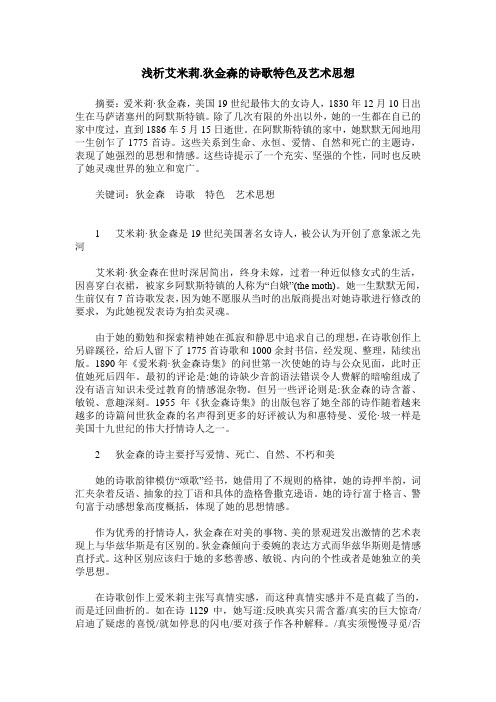
浅析艾米莉.狄金森的诗歌特色及艺术思想摘要:爱米莉·狄金森,美国19世纪最伟大的女诗人,1830年12月10日出生在马萨诸塞州的阿默斯特镇。
除了几次有限的外出以外,她的一生都在自已的家中度过,直到1886车5月15日逝世。
在阿默斯特镇的家中,她默默无闻地用一生创乍了1775首诗。
这些关系到生命、永恒、爱情、自然和死亡的主题诗,表现了她强烈的思想和情感。
这些诗提示了一个充实、坚强的个性,同时也反映了她灵魂世界的独立和宽广。
关键词:狄金森诗歌特色艺术思想1 艾米莉·狄金森是19世纪美国著名女诗人,被公认为开创了意象派之先河艾米莉·狄金森在世时深居简出,终身未嫁,过着一种近似修女式的生活,因喜穿白衣裙,被家乡阿默斯特镇的人称为“白娥”(the moth)。
她一生默默无闻,生前仅有7首诗歌发表,因为她不愿服从当时的出版商提出对她诗歌进行修改的要求,为此她视发表诗为拍卖灵魂。
由于她的勤勉和探索精神她在孤寂和静思中追求自己的理想,在诗歌创作上另辟蹊径,给后人留下了1775首诗歌和1000余封书信,经发现、整理,陆续出版。
1890年《爱米莉·狄金森诗集》的问世第一次使她的诗与公众见面,此时正值她死后四年。
最初的评论是:她的诗缺少音韵语法错误令人费解的暗喻组成了没有语言知识未受过教育的情感混杂物。
但另一些评论则是:狄金森的诗含蓄、敏锐、意趣深刻。
1955年《狄金森诗集》的出版包容了她全部的诗作随着越来越多的诗篇问世狄金森的名声得到更多的好评被认为和惠特曼、爱伦·坡一样是美国十九世纪的伟大抒情诗人之一。
2 狄金森的诗主要抒写爱情、死亡、自然、不朽和美她的诗歌韵律模仿“颂歌”经书,她借用了不规则的格律,她的诗押半韵,词汇夹杂着反语、抽象的拉丁语和具体的盎格鲁撒克逊语。
她的诗行富于格言、警句富于动感想象高度概括,体现了她的思想情感。
作为优秀的抒情诗人,狄金森在对美的事物、美的景观迸发出激情的艺术表现上与华兹华斯是有区别的。
艾米莉·伊丽莎白·狄金森生平简介及其作品赏析.

例2
A narrow Fellow in the Grass
The Brain-is wider than the SkyFor-put them side by sideThe one the other will contain With ease –and You-besideThe Brain is deeper than the seaFor-hold them-Blue to BlueThe one the other will absorbAs Sponges-Buckets-doThe Brain is just the weight of GodFor-Heft them-Pound for PoundAnd they will differ-if they doAs syllable from Sound-
一 两 应 新 永 想 天 地 总
生 度 顾 患 恒 到 堂 狱 是
未 巨 无 又 真 绝 也 也 分
完, 变. 门, 至. 相, 望. 好, 罢, 离.
自然诗
(书P99)benevolent (慈善的)
& cruel
(残忍的)
例1
Over the fence – Strawberries - growOver the fence – I could climb – if I tried, I know – Berries are nice! But - if I stained my Apron – God would certainly scold! Oh dear, I guess if He were a Boy He'd - climb - if He could! 篱笆那边 有一颗草莓 我知道,如果我愿 我可以爬过 草莓,真甜! 可是,脏了围裙 上帝一定要骂我 哦,亲爱的,我猜,如果 他也是个孩子 他也会爬过去, 如果,他能爬过!
艾米丽迪金森诗歌中的激情对自然、爱和死亡主题的研究
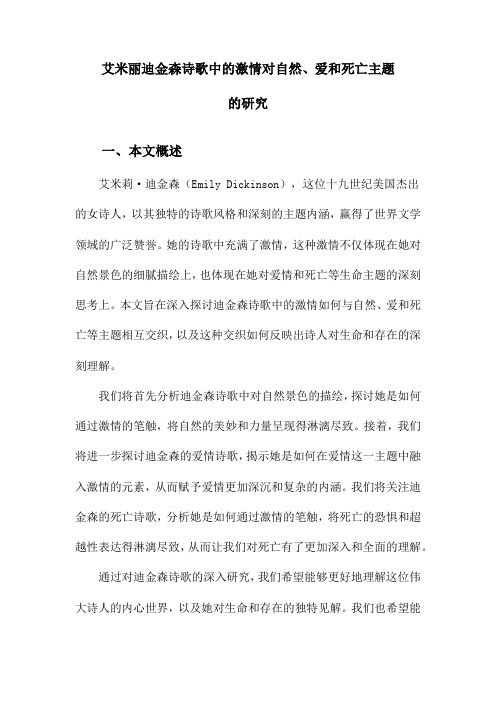
艾米丽迪金森诗歌中的激情对自然、爱和死亡主题的研究一、本文概述艾米莉·迪金森(Emily Dickinson),这位十九世纪美国杰出的女诗人,以其独特的诗歌风格和深刻的主题内涵,赢得了世界文学领域的广泛赞誉。
她的诗歌中充满了激情,这种激情不仅体现在她对自然景色的细腻描绘上,也体现在她对爱情和死亡等生命主题的深刻思考上。
本文旨在深入探讨迪金森诗歌中的激情如何与自然、爱和死亡等主题相互交织,以及这种交织如何反映出诗人对生命和存在的深刻理解。
我们将首先分析迪金森诗歌中对自然景色的描绘,探讨她是如何通过激情的笔触,将自然的美妙和力量呈现得淋漓尽致。
接着,我们将进一步探讨迪金森的爱情诗歌,揭示她是如何在爱情这一主题中融入激情的元素,从而赋予爱情更加深沉和复杂的内涵。
我们将关注迪金森的死亡诗歌,分析她是如何通过激情的笔触,将死亡的恐惧和超越性表达得淋漓尽致,从而让我们对死亡有了更加深入和全面的理解。
通过对迪金森诗歌的深入研究,我们希望能够更好地理解这位伟大诗人的内心世界,以及她对生命和存在的独特见解。
我们也希望能够通过这种研究,启发我们对自然、爱情和死亡等生命主题的深入思考,从而让我们更加珍视和尊重生命,更加勇敢地面对死亡。
二、艾米丽·迪金森诗歌中的自然主题与激情艾米丽·迪金森的诗歌中,自然主题往往与激情紧密相连,呈现出一种深深的、热烈的、甚至近乎痴迷的情感。
她的诗歌语言独特,结构复杂,往往以非常规的韵脚和句式表达她对自然的热爱和对生命的敬畏。
迪金森诗歌中的自然并非单纯的背景描绘,而是诗人情感寄托和哲理思考的媒介。
在她的笔下,自然元素如花朵、树木、飞鸟、溪流等都具有了生命和灵魂,成为了她情感表达的重要载体。
例如,在《一朵红玫瑰》中,她以红玫瑰为象征,表达了对爱情的渴望和追求,同时也展现了自然与激情之间的紧密联系。
迪金森对自然的描绘常常带有一种强烈的主观色彩,她的诗歌中的自然往往是她内心世界的映射。
i am nobody诗歌赏析
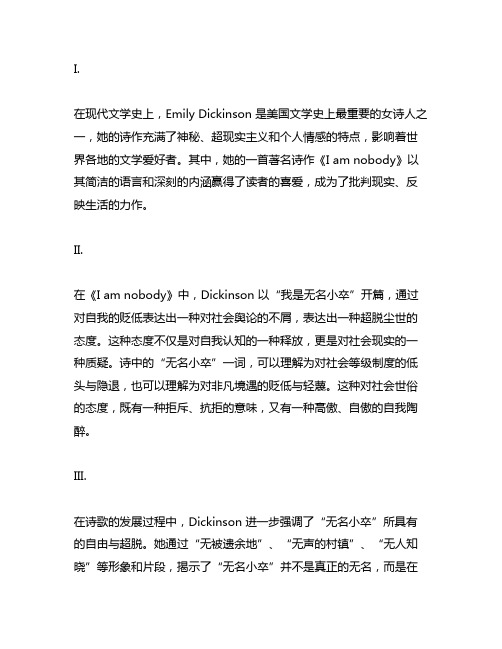
I.在现代文学史上,Emily Dickinson 是美国文学史上最重要的女诗人之一,她的诗作充满了神秘、超现实主义和个人情感的特点,影响着世界各地的文学爱好者。
其中,她的一首著名诗作《I am nobody》以其简洁的语言和深刻的内涵赢得了读者的喜爱,成为了批判现实、反映生活的力作。
II.在《I am nobody》中,Dickinson 以“我是无名小卒”开篇,通过对自我的贬低表达出一种对社会舆论的不屑,表达出一种超脱尘世的态度。
这种态度不仅是对自我认知的一种释放,更是对社会现实的一种质疑。
诗中的“无名小卒”一词,可以理解为对社会等级制度的低头与隐退,也可以理解为对非凡境遇的贬低与轻蔑。
这种对社会世俗的态度,既有一种拒斥、抗拒的意味,又有一种高傲、自傲的自我陶醉。
III.在诗歌的发展过程中,Dickinson 进一步强调了“无名小卒”所具有的自由与超脱。
她通过“无被遗余地”、“无声的村镇”、“无人知晓”等形象和片段,揭示了“无名小卒”并不是真正的无名,而是在逆境中的自立。
她没有丧失自我的价值和尊严,反而在无名中找到了一种相对的自由和质朴的生命力。
这种自由,不是以世俗的评判和期待作为标准,而是以个体的内心和信仰作为出发点。
这种超脱,不是对社会规范的否定,而是对人性的超越与升华。
IV.至于我个人对这首诗的理解,我认为《I am nobody》不仅仅是一首关于个人情感和社会态度的诗歌,更是一种对人类处境和命运的思考。
每个人都是社会中的“无名小卒”,面对种种挑战和压力,面对世俗的诱惑和压迫,我们是否能够保持自我,保持真诚和善良,保持向内心深处的追求和毅力?这是一种非凡的力量和境界,也是一种对普遍人性和生命轨迹的寄托。
我认为《I am nobody》所反映的并不仅仅是 Dickinson 个人的生命经历和情感倾诉,更是一种对人性、对人生的普遍关怀和深刻启示。
V.总结起来,《I am nobody》是一首充满超现实主义、神秘感和个人情感的优秀诗作,它通过对“无名小卒”的贬低和超脱,揭示了一种与社会现实的对立与超越。
had i not seen the sun 赏析

had i not seen the sun 赏析摘要:一、诗歌背景介绍二、诗歌内容解析三、诗歌艺术特点四、诗歌主题阐述五、总结正文:【诗歌背景介绍】“Had I Not Seen the Sun”是一首描绘人物内心世界和人生感悟的诗歌,作者是美国著名女诗人Emily Dickinson。
这首诗写于19世纪末,展现了作者对生活的独特见解和对自然的热爱。
在这首诗中,作者通过对比阳光与阴霾,表达了自己对生活的热爱和对光明的向往。
【诗歌内容解析】诗的第一句“Had I not seen the sun”意味着“假如我没见过太阳”。
诗人以此开头,表达了自己曾经生活在阴霾之中,对阳光的美好充满向往。
第二句“I could bear the dark alone”,说明诗人在黑暗中也能独自承受。
这两句诗展示了诗人坚定的内心和对生活的热爱。
【诗歌艺术特点】这首诗采用了抒情的第一人称视角,使读者更能产生共鸣。
同时,诗人运用了对比手法,将阳光与黑暗进行对比,强调了光明对人心灵的照耀。
此外,诗歌结构紧凑,每两句之间形成鲜明的对照,使主题更加突出。
【诗歌主题阐述】这首诗歌的主题是对生活的热爱和对光明的追求。
在诗中,作者通过自己的亲身经历,告诉读者要勇敢面对生活的困境,坚信光明终会驱散黑暗。
这首诗表达了作者对生活的信念,激励人们在逆境中保持乐观的心态。
【总结】“Had I Not Seen the Sun”是一首充满哲理的诗歌,诗人Emily Dickinson以自己丰富的人生阅历,描绘了光明与黑暗的较量,展示了人性的光辉。
这首诗教会我们要勇敢面对生活的困境,坚信光明会战胜黑暗。
emily dickinson生命主题的诗歌

emily dickinson生命主题的诗歌哇塞,Emily Dickinson 的诗歌啊,那可真是太独特、太有魅力啦!
她的诗就像是一个个神秘的小盒子,你永远不知道打开后会发现什么奇妙的东西。
比如说那首,哎呀呀,那简直就是对生命和死亡的一次奇妙探索!就好像我们在人生的道路上走着走着,突然死神就冒出来了,说要带我们去另一段旅程。
还有,这诗就像是在告诉我们,生命中对美的追求是多么重要呀!这不就跟我们追求自己喜欢的东西一样嘛,为了它可以不顾一切。
Emily Dickinson 用她那简洁而又深刻的语言,把生命中的各种情感和思考都表达得淋漓尽致。
这就好比她是一个超级厉害的画家,用她的诗句当作画笔,在我们的心里画出了一幅幅让人难以忘怀的画面。
她诗歌里的生命主题,有时让你感到温暖,有时又让你觉得有些忧伤。
这不就跟我们的生活一样嘛,有开心的时候,也有难过的时候。
“希望是个有羽毛的东西”,这句话多形象啊,让我们对希望充满了想象。
我觉得 Emily Dickinson 的诗歌就像是一杯陈酿的美酒,越品越有味道。
她让我们对生命有了更深的思考,让我们更加珍惜我们所拥有的一切。
她的诗就是那个能触动我们内心最柔软地方的神奇存在呀!
总之,Emily Dickinson 的生命主题诗歌真的是太精彩啦!值得我们反复去品味,去感受其中的魅力!。
解读艾米莉·狄金森诗歌的女性意识-最新年文档
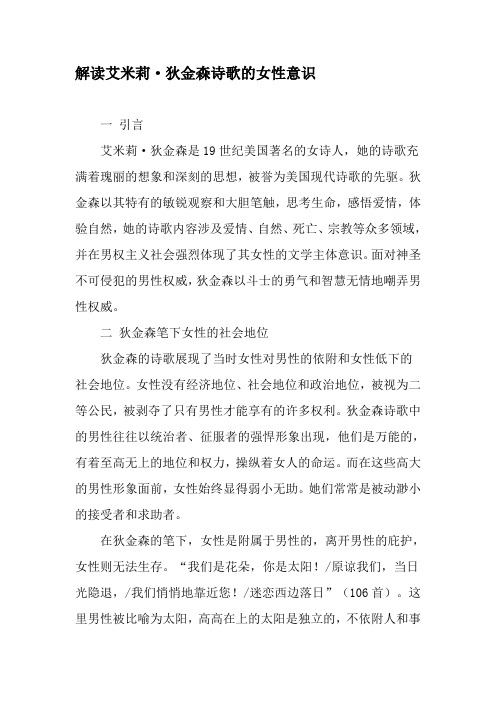
解读艾米莉·狄金森诗歌的女性意识一引言艾米莉·狄金森是19世纪美国著名的女诗人,她的诗歌充满着瑰丽的想象和深刻的思想,被誉为美国现代诗歌的先驱。
狄金森以其特有的敏锐观察和大胆笔触,思考生命,感悟爱情,体验自然,她的诗歌内容涉及爱情、自然、死亡、宗教等众多领域,并在男权主义社会强烈体现了其女性的文学主体意识。
面对神圣不可侵犯的男性权威,狄金森以斗士的勇气和智慧无情地嘲弄男性权威。
二狄金森笔下女性的社会地位狄金森的诗歌展现了当时女性对男性的依附和女性低下的社会地位。
女性没有经济地位、社会地位和政治地位,被视为二等公民,被剥夺了只有男性才能享有的许多权利。
狄金森诗歌中的男性往往以统治者、征服者的强悍形象出现,他们是万能的,有着至高无上的地位和权力,操纵着女人的命运。
而在这些高大的男性形象面前,女性始终显得弱小无助。
她们常常是被动渺小的接受者和求助者。
在狄金森的笔下,女性是附属于男性的,离开男性的庇护,女性则无法生存。
“我们是花朵,你是太阳!/原谅我们,当日光隐退,/我们悄悄地靠近您!/迷恋西边落日”(106首)。
这里男性被比喻为太阳,高高在上的太阳是独立的,不依附人和事物而存在。
而女性却是鲜为人知、微不足道的花朵,女性必须依赖男性,否则就如同花儿失去阳光的照耀而凋零。
男性是太阳,迫使女性不能自己,深深地爱上他。
面对象征男性的强悍者,女性无能为力,只能被动地接受征服。
这是一种强者对弱者强迫式的征服。
“她迎合他的要求,放弃/自己的消遣,/承担起女人和妻子/应引以为荣的责任”(732首)。
在这首诗里,狄金森认为,婚姻泯灭了一个女孩所有的个性与自由,梦想与憧憬。
女孩本应在广阔无边的知识海洋中遨游,本该有志趣爱好,但结婚之后,女孩转变成为了本分的、地位微不足道的妻子,一切都要按照新婚丈夫的要求行事。
在此诗中,男人也是万能的,有着至高无上的地位和权力,操纵着女人的命运。
丈夫一声令下,女人就必须立即去承担女人和妻子的“光荣责任”。
- 1、下载文档前请自行甄别文档内容的完整性,平台不提供额外的编辑、内容补充、找答案等附加服务。
- 2、"仅部分预览"的文档,不可在线预览部分如存在完整性等问题,可反馈申请退款(可完整预览的文档不适用该条件!)。
- 3、如文档侵犯您的权益,请联系客服反馈,我们会尽快为您处理(人工客服工作时间:9:00-18:30)。
Because I could not stop for Death, He kindly stopped for me;The carriage held but just ourselves And Immortality.We slowly drove, he knew no haste, And I had put awayMy labor, and my leisure too,For his civility.We passed the school, where children stroveAt recess, in the ring;We passed the fields of gazing grain, We passed the setting sun.Or rather, he passed us;The dews grew quivering and chill,For only gossamer my gown,My tippet only tulle.We paused before a house that seemed A swelling of the ground;The roof was scarcely visible,The cornice but a mound.Since then 'tis centuries, and yet each Feels shorter than the dayI first surmised the horses' heads Were toward eternity. 我无暇去会死亡爱米莉·伊丽莎白·狄更生我无暇去会死亡,死神便和善地接我前往,我只好放下劳作与闲暇,无法拒绝他的殷勤礼让。
我们一起坐上马车,还有永生陪伴身旁,我们驱车缓缓前行,他悠然自得不慌不忙。
我们经过校园,娱乐的孩子挤满操场,我们经过田野,麦穗张望,我们经过西沉的太阳。
或许该是夕阳经过我们吧,露珠抖动,略显苍凉,只为我的面纱、斗篷,还有我薄丝织就的衣裳。
我们经过一个隆起的土堆,那似乎是一座住房,屋顶几乎无法看见,屋架也在地下埋藏。
感觉比一天还要短暂,虽然自此千万年岁月漫长,我初次产生这种猜测:永恒正是马头所向。
Type of Work“Because I Could Not Stop for Death” is a lyric poem on the theme of death. The contains six stanzas, each with four lines. A four-line stanza is called a quatrain. The poem was first published in 1890 in Poems, Series 1, a collection of Miss Dickinson's poems that was edited by two of her friends, Mabel Loomis Todd and Thomas Wentworth Higginson. The editors titled the poem "Chariot."Commentary and Theme“Because I Could Not Stop for Death” reveals Emily Dickinson’s calm acceptance of death. It is surprising that she presents the experience as being no more frightening than receiving a gentleman caller—in this case, her fiancé (Death personified).The journey to the grave begins in Stanza 1, when Death comes calling in a carriage in which Immortality is also a passenger. As the trip continues in Stanza 2, the carriage trundles along at an easy, unhurried pace, perhaps suggesting that death has arrived in the form of a disease or debility that takes its time to kill. Then, in Stanza 3, the author appears to review the stages of her life: childhood (the recess scene), maturity (the ripe, hence, “gazing” grain), and the descent into death (the setting sun)–as she passes to the other side. There, she experiences a chill because she is not warmly dressed. In fact, her garments are more appropriate for a wedding, representing a new beginning, than for a funeral, representing an end.Her description of the grave as her “house” indicates how comfortable she feels about death. There, after centuries pass, so pleasant is her new life that time seems to stand still, feeling “shorter than a Day.”The overall theme of the poem seems to be that death is not to be feared since it is a natural part of the endless cycle of nature. Her view of death may also reflect her personality and religious beliefs. On the one hand, as a spinster, she was somewhat reclusive and introspective, tending to dwell on loneliness and death. On the other hand, as a Christian and a Bible reader, she was optimistic about her ultimate fate and appeared to see death as a friend. CharactersSpeaker: A woman who speaks from the grave. She says she calmly accepted death. In fact, she seemed to welcome death as a suitor whom she planned to "marry."Death: Suitor who called for the narrator to escort her to eternity.Immortality: A passenger in the carriage.Children: Boys and girls at play in a schoolyard. They symbolize childhood as a stage of life. Text and NotesBecause I could not stop for Death,He kindly stopped for me;The carriage held but just ourselvesAnd Immortality.We slowly drove, he knew no haste,And I had put awayMy labor, and my leisure too,For his civility.We passed the school, where children stroveAt recess, in the ring;We passed the fields of gazing grain,We passed the setting sun.Or rather, he passed us;The dews grew quivering and chill,For only gossamer my gown,1My tippet2 only tulle.3We paused before a house4 that seemedA swelling of the ground;The roof was scarcely visible,The cornice5 but a mound.Since then 'tis centuries,6 and yet eachFeels shorter than the dayI first surmised the horses' headsWere toward eternity.Notes1...gossamer my gown: Thin wedding dress for the speaker's marriage to Death.2...tippet: Scarf for neck or shoulders.3...tulle: Netting.4...house: Speaker's tomb.5...cornice: Horizontal molding along the top of a wall.6...Since . . . centuries: The length of time she has been in the tomb.MeterIn each stanza, the first line has eight syllables (four feet); the second, six syllables (three feet); the third, eight syllables (four feet); and the fourth, six syllables (three feet). The meter alternates between iambic tetrameter (lines with eight syllables, or four feet) and iambic trimeter (lines with six syllables, or three feet). In iambic meter, the feet (pairs of syllables) contain an unstressed syllable followed by a stressed syllable. (For detailed information on meter, click here.) The following example demonstrates the metric scheme........1..................2...............3.. (4)Be CAUSE..|..I COULD..|..not STOP..|..for DEATH,......1..................2.. (3)He KIND..|..ly STOPPED..|..for ME;........1.................2.................3. (4)The CARR..|..iage HELD..|..but JUST..|..our SELVES....1..............2 (3)And IM..|..mor TAL..|..i TY.End Rhyme.......The second and fourth lines of stanzas 1, 2, 4, 5, and 6 rhyme. However, some of the lines contain only close rhymes or eye rhymes. In the third stanza, there is no end rhyme, but ring (line 2) rhymes with the penultimate words in lines 3 and 4.Internal Rhyme.......Dickinson also occasionally uses internal rhyme, as in the following lines:The carriage h el d but just ours el ves (line 3)We sl ow ly dr o ve, he knew n o haste (line 5)We passed the fields of g a zing gr ai n (line 11)The dews grew quivering and chill (line 14)Symbols.......In the fourth stanza, the school symbolizes the morning of life; the grain, the midday of life and the working years; the setting sun, the evening of life and the death of life. Figures of Speech.......Following are examples of figures of speech in the poem. (For definitions of figures of speech, click here.)AlliterationBe c ause I c ould not stop for Death (line 1)he kn ew n o haste (line 5)M y l abor, and m y l eisure too (line 7)At r ecess, in the r ingg azing g rain (line 11)s etting s un (line 12)For only g ossamer my g own (line 15)My t ippet only t ulle (line 16)t oward e t erni t y (line 24)AnaphoraWe passed the school, where children stroveAt recess, in the ring;We passed the fields of gazing grain,We passed the setting sun. (lines 9-12)ParadoxSince then 'tis centuries, and yet eachFeels shorter than the dayI first surmised the horses' heads (lines 21-23)PersonificationWe passed the setting sun.Or rather, he passed us (lines 12-13)Comparison of the sun to a personDeath is personified throughout the poem========================================30. Dickinson’s poems are usually based on her own experience, her sorrows and joys.狄金森的诗都是根据自己的经历和悲欢而创作的。
